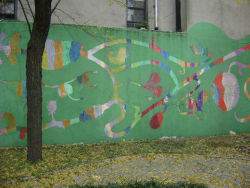St. James Triangle
St. James Triangle
This park, located at the intersection of St. James Place, Oliver, Madison and James Streets bordering the Civic Center, Chinatown, and Lower East Side neighborhoods of Manhattan, takes its name from nearby St. James Roman Catholic Church. The Church is named after St. James the Greater, one of the 12 apostles of Jesus, and one of the Christian faith’s most enduring figures.
Since the early 17th century, Lower Manhattan has been home to generations of immigrants. In 1643, a French Jesuit priest, visiting New York, identified 18 distinct different languages being spoken throughout the city. Less than fifty years later, the island’s religious communities boasted a Jewish temple, several Quaker, Presbyterian, and Independent churches as well as an Anglican church. With the close of the American Revolution, Manhattan served both as the new nation’s gateway for immigration and as a vital port of mercantile commerce. By the mid-1800s, new residents, largely the poor and immigrant populace, began filtering into the Lower East Side’s dilapidated and cramped tenement houses to suffer for a day’s wage in the neighborhood sweatshops and on the nearby docks.
In 1836, St. James Roman Catholic Church began to serve the neighborhood’s largely Irish immigrant Lower East Side community. Built atop the foundation of one of the neighborhood’s oldest breweries, the parish quickly became an influential part of the neighborhood. Dedicated to serving the poor and indigent of their community, the priests of St. James also often cared for cholera patients stranded aboard nearby quarantined vessels; several priests contracted the disease and died shortly after their patients. During the Civil War, the priests of St. James blessed the regimental colors of the Fighting 69th and, around the same time, championed the cause of Catholic temperance in a bid to end local alcohol abuse, ignoring the critical attitudes and admonishments of contemporary Protestant reformers.
In March 1961 Bernard Baruch (1870-1965), advisor to two U. S. presidents, successful New York financier, and donator of several large grants to New York City’s ongoing development and restoration projects, gave $30,000 to Parks for the creation of this sitting area. Adjoining the Spanish and Portuguese Jewish Cemetery, one of the oldest Jewish cemeteries (1682) in the United States, the site’s previous structures, a parking garage and tenement, were rapidly demolished and replaced with benches and greenery. A bronze plaque was placed on a nearby wall in 1965 to commemorate Bernard Baruch’s efforts on behalf of one of New York’s oldest neighborhoods. Renovations occurred in 2000, including sidewalk repaving and other site improvements.
Check out your park's Vital Signs
Clean & Safe
Green & Resilient
Empowered & Engaged Users
Share your feedback or learn more about how this park is part of a
Vital Park System


